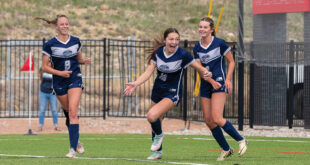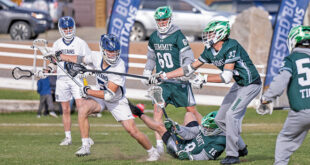Avalanche forecasters like the way the season started
After a November so dry it had locals questioning whether winter would show up at all, the heavens smiled on the valley, and before the second week in December was over, 80 inches of the fine white fluffy stuff fell on Colorado’s last great ski town.
“The way winter set up this year was awesome,” says longtime Crested Butte local Xavier Fane. “We were biking all the way through November, and now because the snow came in pretty moist with no weak layers underneath, it has bonded really well.”
To a back country skier like Fane, the bonding of the layers of snow crystals is important, because if snow falls in different storms in different consistencies, or there are wide temperature variations, each snow layer may have little to adhere to—and that’s when avalanche danger is greatest.
Jayson Simons-Jones of the Crested Butte Mountain Guides says he was also awed by the early-December dump.
“I’ve never seen it go from nothing to waste-deep winter,” he says. And like Fane, he’s pleased with the timing. “Usually we get some big snows in October and November, then it gets real cold and the snow just sits there and rots,” he adds. “It gets super-dangerous.”
According to Simons-Jones, this year’s snowpack is ideal so far. “We’ve always said that if the snow would just hold off until December and then just start pounding, it would be perfect,” he says. “Well, this year, that’s exactly what happened.”
But he says caution must be exercised. “It’s not a no-brainer,” he says. “There are still some sketchy layers out there.”
The avalanche danger, says Simons-Jones, was really high on Saturday and Sunday, December 8-9, because of the volume of new snow.
“There were tons of natural releases during the storm,” he says. “It’s just that no one saw them because it was snowing so hard.”
For the first couple of days of the big dump, local part-time skier extraordinaire and full-time climate activist Alison Gannett was content to ski on the resort while she waited for the slide danger to abate. But once she felt the danger had receded, Gannett could be found at her favorite backcountry haunts like Washington Gulch and Red Lady Bowl.
Although she’s still glowing after the last few days of backcountry adventures, Gannett says the fact that it was an unusually damp and powerful storm is cause for concern.
“We’re used to getting continental storms,” she says of the normally dry, cold storms that afflict the area. “This was more of the moisture-laden intercontinental storm pattern—more typical of Alta and Snowbird,” she explains.
According to Gannett, the shift in local weather patterns is a harbinger of a warming planet, which, despite the massive dump last week, may not bode well for Crested Butte’s skiing future.
“We’re likely to get more powerful, wetter storms,” she says, “but we’re also likely to see more droughts.”
Although Gannett cannot help but worry about the warming trend that has already closed ski resorts in the Alps and has Colorado resorts running scared, she’s clearly reveling in this December’s gift from Mother Nature.
“The backcountry is exceptional right now,” she says.
Simons-Jones says he is just hoping it will keep snowing. He says it gets really cold with no precipitation, that’s when the unstable layers have a chance to set in.
But so far, Simons-Jones says he couldn’t be happier about the way things are shaping up for an epic season of backcountry skiing. “I think we’re set for a really good year,” he says.
Like Fane, Gannett’s backcountry mode of travel is a set of skin-equipped fat skis with all-terrain (AT) bindings. “Skins”—so-named for their early predecessors that were actually made out of the skin of an unlucky seal—are simply strips of synthetic fur attached to the bottom of the ski that allow the skier to slide forward but not backward. Thus equipped, it only takes the will (and some muscle) to reach the highest surrounding peaks—sans lift.
For those who are new to backcountry skiing, Gannett recommends taking an avalanche course. Crested Butte Mountain Guides offer classes of several levels and Babes in the Backcountry are presenting a woman-specific Level I avalanche course in Crested Butte Friday through Sunday, January 11-13.
“The women’s avalanche courses are a lot better tool for learning than following your boyfriend,” she says.
But according to Gannett, a little knowledge is sometimes a dangerous thing.
“The most likely victim of an avalanche is a 24-year-old male with Level I avalanche training,” she says.
Crested Butte local Ben Pritchett, who is the education coordinator for the Colorado Avalanche Information Center, says knowledge of local conditions is paramount for safe backcountry travel.
“Take an avalanche course and check in daily for local avalanche conditions,” Pritchett suggests to those thinking of venturing into the backcountry this winter.
And he says riders should be properly equipped. “An avalanche beacon, a probe and a shovel are mandatory,” he says.
He also advises novices to stick to safe terrain. “Ridge tops and densely forested slopes less than 30 degrees without steep slopes above them are the safest areas,” he says.
Like Simons-Jones, Pritchett says the recent storm put down a nice solid base, and since it all came at once, there generally isn’t a layer of faceted or “sugar” snow at the ground level, which is usual for the Crested Butte area snowpack.
But he says unstable conditions still exist, particularly at the high elevations where there is still an old layer of snow left over from October. And he reminds riders that because of factors such as wind, added precipitation and wide temperature changes, snow conditions are constantly changing—often very rapidly.
“By the time this article comes out, conditions are likely to be quite different,” he says.
Pritchett says in a perfect world, storms would continue to pound the area the rest of the season, further compacting the base.
“Suddenly we would be in Mecca,” he says.
Pritchett says up-to-date snow conditions can be found at the Colorado Avalanche Information Center, http://avalanche.state.co.us/ and the Crested Butte Avalanche Center, www.cbavalanchecenter.org.
 The Crested Butte News Serving the Gunnison Valley since 1999
The Crested Butte News Serving the Gunnison Valley since 1999

